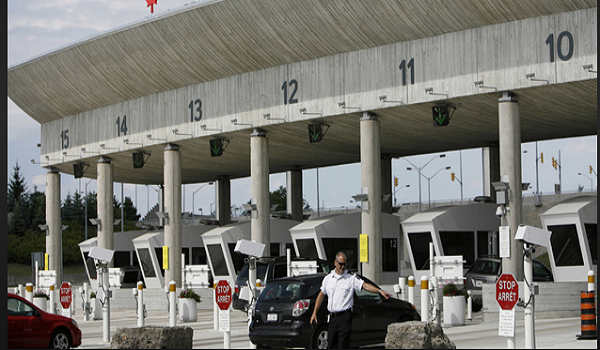Enough of U.S. dependence on: Canada can pull away from America and thrive, economists say
When U.S. President Donald Trump threatened to launch a full-blown trade war with its closest ally, many Canadians felt as if their best friend had suddenly turned around and stabbed them in the back.
Trump’s string of accusations, along with increasingly hostile suggestions that the U.S. annex Canada as “the 51st state,” have led many to pledge boycotts of American products. The majority of Canadians now support calling on the government to reduce our reliance on the U.S. as a trading partner, according to a recent poll by the Angus Reid Institute of more than 1,800 adults.
Patriotism aside, there are solid economic reasons why Canada might want to consider reducing trade with America, according to economists. Trump’s threats have introduced a major source of uncertainty in a decades-old trade partnership that saw Canada give up some of its independence in exchange for economic prosperity and stability.
It’s a relationship that has benefitted both economies, with nearly 80 per cent of Canadian exports currently ending up south of the border, but it was built on trust, and trade experts say that trust is now gone.
Is achieving a greater degree of economic independence from the U.S. really possible? Can we really undo decades of integration without seeing our economy crumble?
The Star spoke with economists, academics and other experts about how the country should best navigate this new era of Trump’s isolationism, and found there are realistic steps we can take to reduce our dependence on the States.
“We can’t count on the United States anymore,” said Blayne Haggart, associate professor of political science at Brock University. “Trump’s only question is: how much can we get out of Canada next time?”
Canada’s ‘third option’
Discussions around how to manage a complex but fruitful relationship with the U.S. are not new, as Canada’s natural trade flow has always been north to south rather than east to west.
“The basic problem that Canada faces is very simple and it’s not changeable,” said Dan Ciuriak, a former deputy chief economist at Foreign Affairs and International Trade (now Global Affairs Canada), who now works as a trade consultant.
Our economy is “strung along the U.S. border,” he continued. “For every major Canadian city, the next closest major city is in America, not in Canada.”
Brock University’s Haggart says Trump’s trade war threat resurfaced a debate dating back to the 1970s. After the U.S. adopted protectionist measures in 1971, then-secretary of state for external affairs Mitchell Sharp wrote a paper proposing three options for Canada’s future: maintain the existing relationship with the U.S.; move toward closer integration with the U.S.; or strengthen the Canadian economy and, in the process, reduce Canadian vulnerability to decisions made in Washington.
At the time, Canada chose the second option, eventually adopting the Canada-U.S. Free Trade Agreement in 1989. The difference between then and now, says Haggart, is that now “we’re being forced into the third option.”
“The relative cost of focusing only on the United States is going up because that uncertainty is always going to be there,” he added, “because the United States has destroyed its credibility. That’s the bottom line.”
Diversifying our trade partners
Some believe Canada can become less vulnerable to economic threats from the U.S. by investing more into diversifying its trade relationships.
Ottawa is currently in trade talks with the Association of Southeast Asian Nations, for example, and it’s been a close trading partner with the European Union through the Canada-E.U. Comprehensive Economic and Trade Agreement.
“We’ve got some good trade agreements and we’re negotiating more,” said Patricia Goff, a professor at Wilfrid Laurier University specializing in international trade governance. “The challenge is the incentive structure for exporters.”
Selling south of the border is easy, while switching markets can be costly and takes time, she explained.
But Goff thinks exporters now have more incentive to look for different buyers after Trump made the U.S.-Canada relationship unpredictable. “That, I’m sure, is going to make certain exporters think twice about whether they want to rely on the U.S. market, or whether they should consider other markets.”
But others are skeptical of trade diversification being a viable solution.
“We’ve already covered the major part of the trade liberalization potential that is out there,” said trade consultant Ciuriak. “The major one that’s outstanding really for us is China. But that’s a geopolitical problem right now.”
“It certainly is not enough to offset the impact of a 25 per cent tariff (at) the U.S. border. So we have to look at it differently.”
Boosting interprovincial trade
Nearly all Canadians — 95 per cent — believe the country should work quickly to eliminate interprovincial trade barriers, according to the Angus Reid survey.
These barriers generally aren’t tariffs, but rather differences in regulation — such as rules around health and safety or the licensing of professionals — that make trading harder between the provinces, said Goff.
If these invisible hurdles are removed, it could strengthen the domestic economy by boosting gross domestic product per capita by about four per cent, according to a research paper published by the International Monetary Fund in 2019.
“We’ve seen efforts to lift them over the years,” said Goff. “It’s just a tough thing — obviously there are interests involved. There are people who benefit from those barriers, sectors that benefit from those barriers.”
In 2017, Canadian ministers signed the Canadian Free Trade Agreement, which seeks to facilitate interprovincial trade by reducing and eliminating the “barriers to the free movement of workers, goods, services and investments in Canada.”
“Provincial governments are powerful and that’s in the Constitution, so you don’t just turn this over easily,” said Goff. “But now we’ve got a new incentive.”
Prime Minister Justin Trudeau recently stressed the need to drop such barriers, saying there is no lack of political will because all premiers say they support the idea.
“It’s about time we had genuine free trade within Canada,” Trudeau said.
Investing in the local economy
Canada has a business investment problem. While U.S. spending has been increasing, Canadian investment levels are lower than they were a decade ago, according to the Bank of Canada, contributing to our economic vulnerability.
Much of the money spent by Canadians is not being reinvested in the local economy. According to the Canadian Federation of Independent Business, only about 11 cents of every dollar spent stays in the community when consumers shop at a large multinational business.
“Yes, it’s great to have big growth-oriented firms,” said Matthew Mendelsohn, CEO of Social Capital Partners, an organization promoting social finance in Canada. “But it’s also really important for our economic resilience at a moment like this — when we have ongoing threats — that we have vibrant, diverse, locally owned businesses that aren’t just branches, plants or subsidiaries of American firms, or owned by American investment houses, but that they are small and medium-sized businesses that are Canadian-owned and have commitment to the Canadian economy.”
Mendelsohn believes the government could, for example, spend procurement dollars to purchase from Canadian businesses and entrepreneurs. The solution will also require efforts from large Canadian corporations and institutions, he says.
“It’s also about banks, pension funds, philanthropic capital, and the endowments at universities and colleges and hospitals making choices to invest in … Canadian businesses and being more aggressive in how they can invest their capital in ways that support the long-term resilience and vibrancy of Canadian community economies,” he said.
Ciuriak thinks Canada could also focus on digital innovation to become a more attractive trade partner.
“The good news is that Canada is actually very good at producing technology,” he said. “If we modify our business model so that we capture the benefits of innovation, we could have a lot of Canadian startups becoming Canadian unicorns and becoming global stars. We’ve done it before. We can certainly do it again.”
Perhaps amid surging national pride, Canadians can take heart in knowing that Trump might have done us a favour — like good neighbours do — by forcing us to reflect on how we can strengthen our economy from within.
This article was first reported by The Star













